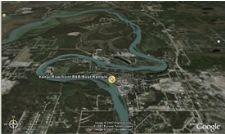For most sport fishers in America, the Arctic grayling (Thymallus arcticus (Pallus)) is a rare freshwater game fish symbolic of the clear, cold streams of the northern wilderness. Grayling occur throughout the arctic as far west as the Kara and Ob rivers in Russia and east to the western shores of Hudson Bay in Canada. Once as common as far south as Michigan and Montana, the Arctic grayling has almost disappeared from the northern United States because of overfishing, competition from introduced species, and habitat loss.
General description: The Arctic grayling is an elegantly formed cousin of the trout. With its sail-like dorsal fin dotted with large iridescent red or purple spots, the grayling is one of the most unusual and beautiful fish of Alaska. Grayling are generally dark on the back and have iridescent gray sides. They have varying numbers of black spots scattered along the anterior portion of both sides. The adipose, caudal (tail), pectoral, and anal fins are dusky brown and the pelvic fins are often marked with pink to orange stripes.
Life history: Grayling have evolved many strategies to meet the needs of life in what are often harsh and uncertain environments. Grayling can be highly migratory, using different streams for spawning, juvenile rearing, summer feeding, and overwintering. Or, in other areas, they can complete their entire life without leaving a short section of stream or lake. Winter generally finds grayling in lakes or the lower reaches and deeper pools of medium-sized rivers such as the Chena and Gulkana, or in large glacial rivers like the Tanana, Susitna, and Yukon. Their tolerance of low dissolved oxygen levels allows grayling to survive the long winters in areas where many other salmonids would die. With the coming of spring, grayling begin an upstream migration to spawning grounds. Like salmon, grayling faithfully return every year to the same spawning and feeding areas. Grayling spawn for the first time at an age of 4 or 5 years and a length of about 11 to 12 inches.
About one month after spring breakup, adult grayling begin their post-spawning migration to summer feeding areas. Depending on where they have spawned, the distance traveled can be up to 100 miles. By the middle of summer, grayling will segregate within a stream according to age and maturity. The older adults will be found in the upper reaches of river and stream systems, the sub-adults in the middle, and the juveniles in the lower ends. Grayling fry hatch about three weeks after spawning, and they tend to occupy the quieter waters near where they were spawned. In the early fall, grayling again begin a leisurely downstream migration to reach overwintering areas.
Distribution: During the Ice Age, Arctic grayling survived in unglaciated areas of Alaska in the Yukon River valley and the North Slope. From there, they have spread throughout Alaska, except Kodiak, Southeast Alaska, and the Aleutians. Grayling have since been stocked into a few lakes in southeastern Alaska and on Kodiak Island.
Food habits: Grayling are generalists in their food habits, but drifting aquatic insects, especially mayflies, stone flies, and caddis flies are their primary food items. At times grayling will gorge upon the eggs of spawning salmon, outmigrating salmon smolts, terrestrial insects that have fallen into the water, or even an occasional vole or shrew!
Fishing: The tendency of grayling to eat almost anything endears them to the angling public. Any fishing technique, including bait, lures, and flies, will work at one time or another. Grayling are especially popular because of their willingness to rise to a dry fly. Flyfishing techniques for grayling are similar to those used for any trout species. Grayling are often easy to catch, but, as with other species, the most skilled anglers with the best knowledge of grayling feeding patterns and how to fish the water will be most successful. Generalized insect imitations such as the dry fly "Adams" and the "hare's ear nymph" are usually effective patterns for grayling. However, when feeding on a specific insect, grayling can be very finicky and the angler challenged to "match the hatch".
The largest grayling fisheries occur along the road system in Interior Alaska. However, larger-size fish are generally caught in less heavily fished areas. Over 70 percent of the trophy grayling (greater than 3 pounds) registered by the Alaska Department of Fish and Game come from the famous Ugashik Lake and river system of Bristol Bay. The state record grayling, 23 inches long and weighing 4 pounds 13 ounces, was caught in the Ugashik Narrows.
Courtesy of ADF&G
Text: Rocky Holmes
Illustration: Ashley Dean
Revised and reprinted 1994






